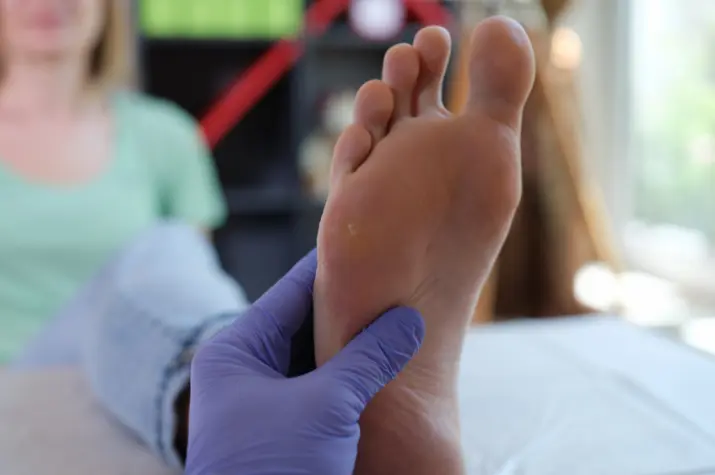
Plantar fasciitis is a common and often painful condition that affects the bottom of the foot, particularly the heel and arch.
It happens when the thick band of tissue called the plantar fascia is inflamed or irritated, causing symptoms like heel pain, stiffness, and trouble walking.
This comprehensive guide will explore everything you need to know about plantar fasciitis, empowering you with the knowledge and tools to overcome this orthopedic issue and regain mobility and comfort in your feet.
Understanding the Anatomy of the Foot
To understand plantar fasciitis, it’s essential to familiarize yourself with the anatomy of the foot and the role of the plantar fascia in supporting its structure and function. From the heel bone to the toes, a thick band of connective tissue called the plantar fascia runs down the bottom of the foot.
It supports the arch of the foot and aids in the equal distribution of weight while running, walking, and engaging in other weight-bearing activities. It functions as a shock absorber.
Common Causes and Risk Causes
Several causes, including biomechanical issues, overuse or repeated stress, and certain lifestyle choices, can result in plantar fasciitis.
The extra pressure that weight-bearing activities impose on the plantar fascia increases the likelihood of developing plantar fasciitis in those with flat feet, high arches, or poor foot mechanics.
Likewise, prolonged standing, leaping, and running are examples of activities that can cause repeated stress on the foot and eventually lead to plantar fasciitis.
Read also: Facts About Your Foot You Didn’t Know
Symptoms and Diagnosis

The hallmark symptom of plantar fasciitis is heel pain, particularly with the first steps in the morning or after prolonged periods of rest.
Movement expands and heats the plantar fascia, which can progressively relieve this discomfort, which can often be described as severe or stabbing. But after extended weight-bearing or vigorous exercise, it could become worse again, making walking more uncomfortable and difficult.
Plantar fasciitis patients can also experience stiffness and soreness at the bottom of the foot, especially around the arch and heel, as well as heel discomfort.
The discomfort can radiate toward the toes or up toward the ankle and run the whole length of the plantar fascia. In extreme situations, plantar fasciitis can cause swelling and inflammation in the afflicted region, which aggravates symptoms and limits the range of motion.
Options for Treatment and Management
The goals of treating plantar fasciitis are usually to reduce pain and inflammation, reduce the tension on the plantar fascia, and encourage the body’s natural healing process.
To relieve stress and stiffness in the calf muscles and Achilles tendon, conservative treatment options may include rest, ice therapy, nonsteroidal anti-inflammatory medications (NSAIDs), and stretching exercises. During weight-bearing activities, orthotic devices like night splints or shoe inserts can support the foot’s arch and reduce the strain on the plantar fascia.
However, for moderate or severe cases, you should consult a doctor who specializes in plantar fasciitis in Upper East Side Manhatten, or where you live, to get the best possible treatment.
Prevention Strategies and Lifestyle Modifications
Preventing plantar fasciitis involves adopting healthy lifestyle habits and making modifications to reduce your risk of injury and inflammation in the feet.
This involves using arch-supporting and sufficiently cushioned footwear, especially while engaging in high-impact exercises like jogging. To lessen the tension on your plantar fascia and raise your chance of getting plantar fasciitis, avoid wearing old or poorly fitted shoes.
Your risk of overuse issues like plantar fasciitis can be decreased by including stretching and strengthening exercises in your daily routine, in addition to wearing appropriate footwear.
Read more: 5 Tips on Strengthening Your Joints and Improving Mobility
These measures can assist in improving flexibility, mobility, and stability in the lower extremities. During exercise, pay attention to your body’s signals and avoid overtraining or pushing through the discomfort because this could increase your risk of foot and ankle problems.
Conclusion
Plantar fasciitis is a common and often painful condition that affects millions of individuals worldwide, impacting their ability to walk, run, or engage in physical activity.
You can successfully manage your symptoms and avoid persistent problems by being aware of the causes, symptoms, and available treatment options for plantar fasciitis.
With proper treatment and management, you can alleviate your symptoms, promote healing, and regain mobility and comfort in your feet, allowing you to live an active and fulfilling life.
About The Author:
Stacey Smith is a freelance health writer. She is passionate about writing about women’s health, dental health, diabetes, endocrinology, and nutrition and provides in-depth features on the latest in health news for medical clinics and health magazines.




